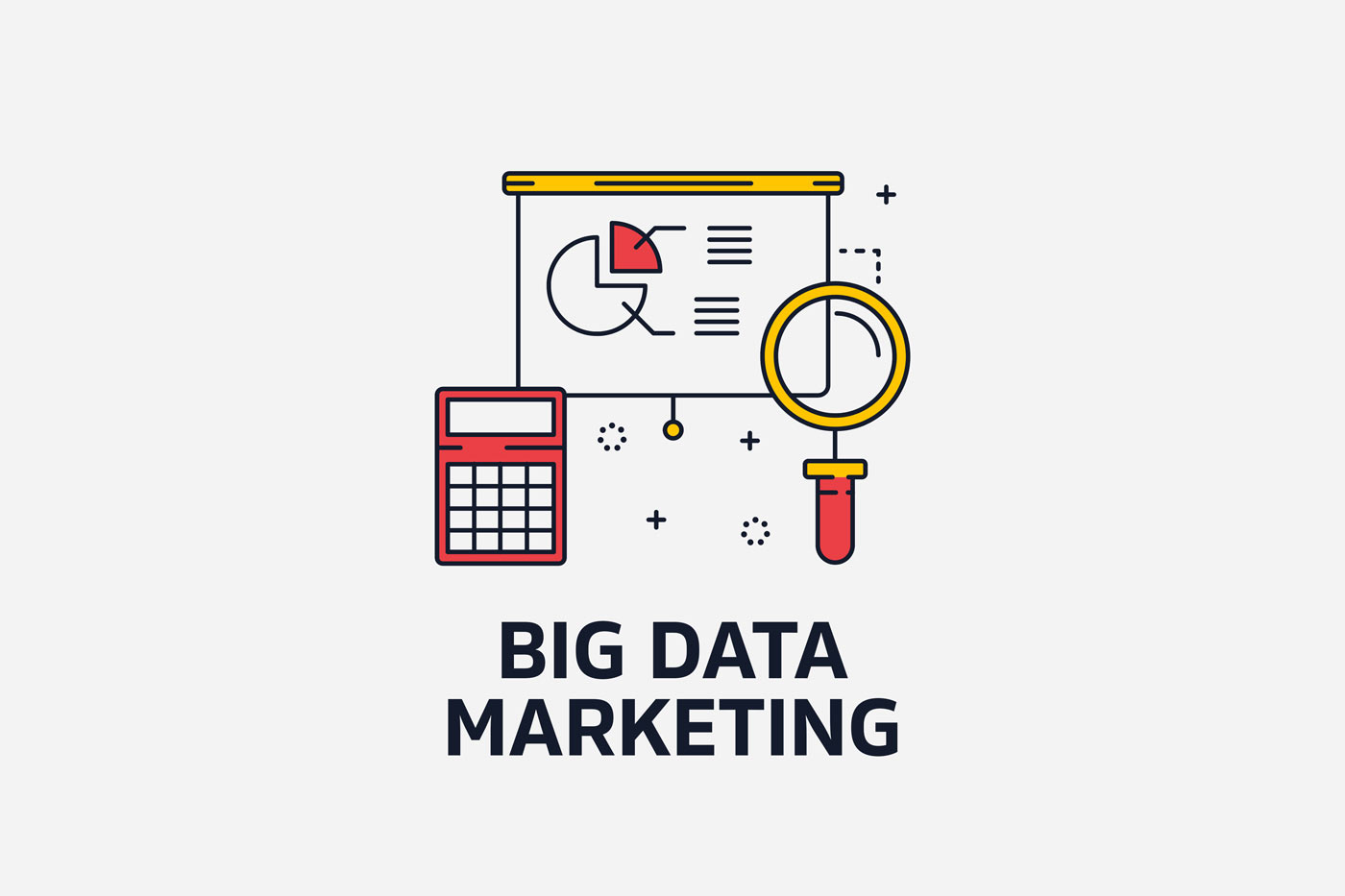Big data marketing is changing the way businesses make decisions by integrating more analytics into their strategic rationales. Data has increased dramatically in recent years (with the famous Moore law still being valid in sales and marketing, too) and now more marketers are focusing on big data for strategic and tactical purposes.

The harsh reality of Big Data Marketing
Marketing lives in the customer data era. Because of accelerated digitalization, data is more accurate and timely than ever before. The truth is that most marketers fail to dedicate enough time to gather, analyze and use Big Data sets in their marketing activities as they are tight to old procedures of monthly reports prepared the traditional way by analysts or juniors.
In marketing, big data is not just customer analytics gathered in the same data dashboard, but pure business intelligence which must be managed by experienced, digital-savvy marketers.
How Big Data in Marketing became so important
As people and companies all over the world embraced the digital media frenzy, Google, Facebook, Twitter, Tumblr, Facebook, Clubhouse, and other big tech companies with millions of users had the objective to monetize their traffic.
The smartest way for big tech companies was to invest in big data marketing analytics systems that would support both their revenue growth plans but also showing to every marketer interested in advertising on their platform that big data can help them make overcome their competitors.
As a consequence, now many business decisions are based on big data marketing tools. This reality also helped sales and marketing experts to gather big data marketing experience, generate great case studies, and master user data statistics.
As the world’s greatest tech giants are increasingly attracted to big data analytics technologies that provide them with structured data and complex insights, we have the chance to learn from them and apply data science techniques to the customer data that we own.
[sc_fs_faq html=”true” headline=”h2″ img=”5683″ question=”What is Big Data Marketing?” img_alt=”What is Big Data Marketing?” css_class=””] It refers to the high volumes of complex user data that is produced and stored too fast for a marketing team to manage by using traditional data processing methods and tools. [/sc_fs_faq]What generates the highest volumes of Big Data in marketing?
The act of accessing and storing information in huge quantities is most familiar to the specialists working in the digital marketing field. Specialists say that a mid-sized company with 3 active social media channels used for posting and advertising generates every year at least 1 million data items.
How do companies process large databases, what are the selection criteria, and especially how do they use them in the company differs very much based on how important the digital customer is for the company (usually dictated by the revenue share generated through digital channels).
http://dev.stefanstroe.com/big-data-in-healthcare/
The characteristics of Big Data
The new concept began to be developed as early as the 2000s when analyst Doug Laney (Data & Analytics Innovation Fellow at West Monroe | Author of “Infonomics”) synthesized the definition of big data, which is based on 3 Vs: Volume, Variety, and Speed.
The Speed
Speed is the first important trait of Big Data in Marketing, as the Internet of Things has developed at a fast pace, creating an avalanche of data entering a company quickly and requiring real-time management. RFID tags, smart meters, and sensors develop the need to face these data torrents in real-time.
The Volume
Companies collect data from a multitude of sources, some of which can be smart devices (loT), videos, social media, industrial equipment, and other more creative sources. If in the past there was the problem of storage for the high volume of data as it was limited and very expensive, now we have plenty of cloud storage platforms that solve the issue of high information volumes.
The Variety
Data is produced in different forms, from structured, numerical information stored in traditional databases, to data from text, video, email, audio, customer private data, and transactions stored in more complex and secure databases.
To these 3 main dimensions could be added two more: variability and veracity.
Big data analytics in action
Managing big data in marketing is like having a newborn. You can never rest and the team responsible has to put data (customer) listening as a Level 0 alert.
For example, if the speed and variety of big data sets increase, data flows may become unpredictable, showing frequent changes and variations.
In order to overcome this risk, the marketing team needs to be connected to the trending big data insights (e.g. email marketing, eCRM automation) and be able to manage any daily, seasonal data peak triggered by event algorithms.
The main problem with using big data in marketing
A major challenge for marketers with importing first-hand data to a single platform like Power BI or Google Data Studio is to ensure the big data is correct and complete.
Faults in big data collection algorithms
There are situations when a big data check collecting procedure is faulty, causing a chain reaction in altering several dashboards and big data marketing alerts.
Big data inconsistency issues
The most common problem with integrating big data sources is data inconsistency, as information is imported from different big data sources makes it very difficult to match data fields, segment correctly big data sets, clean data tables and translate customer content into a language comprehensible by the whole team.
Missing or incorrect correlation algorithms
Econometry gives us plenty of insights on what dependent and independent customer variables are and how relevant they are in sales and marketing.
Besides collecting separate data sets and red/green flagging big data events, a big data project is supposed to connect and correlate relationships, but also to perform hierarchies between data sets.
By using “beta” or unverified correlation algorithms that are shared with top management may increase the risk of setting the strategy on the wrong foot or of missing important data events related to customer acquisition, customer loyalty, customer churn, and user base growth.
How to apply big data in digital marketing
Big data opens a new era in creating more accurate than ever user targeting and marketing campaigns can benefit from using advanced tools that consumer behavior data.
By using advanced data analytics for customer acquisition we eliminate almost completely any “guesstimation” from real-time market segmentation.
Through this method, marketers can create buyer persona by using various data collected from customers:
- user preferences;
- consumer behavior;
- shopper marketing insights;
- lifestyle data.
What digital marketing techniques can be used in big data collection?
Cookies
They are small data files that gather information about customer activity while browsing the Internet and generate personalized data in the process. As you may have read already, the digital industry shifts now towards first-party cookies only, which does not affect big data eCommerce and marketing projects.
Social Media
It is a source for big data projects for markers, which includes critical KPIs such as user engagement, ad investment efficiency, reach, and conversions.
Transactions
By tracking the transactions for your web stores or digital ordering platforms, you can find insights about how customers act and what their buying preferences are which you can use by importing certain KPIs in your central cloud data storage.
Web mining
It is an automatic process by which data is extracted from the web using specific IT tools in order to understand the structure of data (source: Wikipedia).
Market research firm Gartner created a report on July 1, claiming that by 2022, 75% of all databases will be deployed or migrated to a cloud platform, mostly for databases used as Software-as-a-Service (SaaS) applications.
What are the types of big data for marketers?
If we are to classify big data marketing based on the source we generally look at three categories: customer, financial, and operational. These three types of data however can be further split into unstructured, semi-structured, and structured.
Let’s see in detail these three types of big data that are used in real life by companies that are data-driven:
- Structured data – It is user information classified via consistent criteria throughout all databases. The best way to have your data structured is to prepare the sources of origin before integrating them into the single database. For example, eCRM can deal only with structured data collected from their customers or imported from market or business research tools. Of course, the marketing efforts to ensure accurate data analysis and use sales big data to identify growth insights is a big challenge for any marketer, but preparing well is crucial.
- Unstructured data – Customer information available in large amounts of data, that is using no criteria to differentiate between data sets, except maybe for the source of origin. Usually, this type isn’t often encountered in today’s marketing world especially if you import primary data from structured databases such as Google Analytics, Hubspot, or your web store.
- Semi-structured data – Represents user information and insights that a business possesses and which is a mix of structured and unstructured data. In real life, it takes a lot of marketing efforts to perform data analysis and drive customer engagement through semi-structured information.
Sources:
